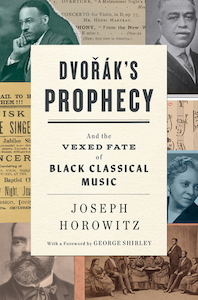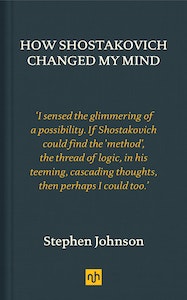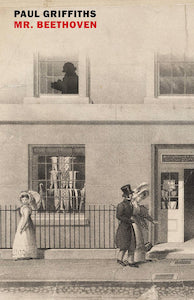Dvořák’s Prophecy, Shostakovich as Cure and Beethoven in Boston
|
Grant Chu Covell [November 2022.] Joseph HOROWITZ: Dvořák’s Prophecy and the Vexed Fate of Black Classical Music (2022). W.W. Norton ISBN 978-0393881240 (www.wwnorton.com). Should you read one book on music this year, then this is the one. Horowitz’s newest is timely and relevant. It ought to spark fresh conversations and new directions. But then again, when has a book about Classical Music History ever made a dent on how American music is taught, programmed or recorded? Since when has a nonfiction analysis of American music been a current topic? For me, this book is opportune. Now and again, I wonder why I find it hard to summon excitement about new American music. There are many reasons and Horowitz solidified a foundation and identified a few details. But first, a few points about his book, before my thoughts wander. Czech composer Antonín Dvořák visited and worked in this country in 1892-95. Sparked by the “negro melodies” he heard, he envisioned this continent would thenceforth build a repertoire of musical material derived from Black music. We know that this did not happen. 19th- and early 20th-century African American composers are only just being discussed (Burleigh, Dett, Dawson, Price, et al.). American music after Dvořák’s visit went in different directions. Horowitz suggested that a few composers might have turned the tide, even if they were acting independently of Dvořák’s pronouncement. However, despite bursts of affection, Ives and Gershwin have always been labelled as outsiders. Horowitz makes the case that Thomson, Copland and Bernstein found it convenient to ignore America’s musical past (sexual orientation also had a part to play), and that unlike museums or schools, America’s orchestras do not honestly attempt historical or academic appraisals as they try to fill seats. There are fighting words here, probably some thoughts and appraisals which may make some uncomfortable, but Horowitz is no stranger to this arena. Examining literary heavyweights such as Melville, Twain and Whitman, Horowitz makes the case for how writers incorporated American stories, themes and experiences, whereas American composers often chose different predominantly European influences. There is a detailed discussion of the role played by critics and America’s earliest cultural historians routinely blind to their biases. There’s no doubt that European immigration forged America’s cultural identity, especially as it related to musicians, composers and their repertoire. Today’s top American orchestras perpetuate a cycle of proselytizing a handful of classics as opposed to constantly reinventing themselves or attempting a curatorial mission. Consider the public’s interest in new movies and books compared to new contemporary music, or how an artist’s retrospective at a museum will attempt to be comprehensive, chronological and contextual, not just the streamlined replay of a single favorite. We learn that “American Music” is an invented and rootless conception, not linked to any indigenous tradition. Horowitz suggests that Thomson, Copland and Bernstein were at the center of this “pastlessness,” summarily rejecting any American music written before (such as Chadwick, Paine or Ives). This was a lightbulb moment for me. We’ve been inoculated to think of Appalachian Spring as quintessentially American, whereas Ives’ Concord Sonata is a well-intentioned but amateurish mishmash. What if the standards were reversed? And there’s also jazz, disdained by most “art” composers and assigned labels that linked it to particular races and classes. Perhaps jazz reflects Dvořák’s vision. American art music was nurtured by European immigrants and in the 20th-century, coalesced around either the Stravinsky or Schoenberg camp. Or the serial or tonal camp. To its benefit, American music today is rich with many threads, but lacks a common root. Maybe this is an important defect, or perhaps, it’s just the way it is. I am reminded of my own conservatory education which prioritized Classical European models and fetishized American innovators. Arguably we should continue to study Beethoven and Sonata Form, but the center of gravity could shift to more comprehensively absorb Cage, Glass and Carter. Horowitz does not discuss how American conservatories developed over the years, and how the training of musicians and composers has reinforced our flawed norms. This would be a nifty line of research for the future. I think about composers I’ve been drawn to. To look at recent examples, they have all found ways to incorporate history: Winbeck (in progress), Pesson, Silvestrov, or have rigorously examined themselves and the world around them: Nono, Ferrari. So many American composers are oblivious to history, the surrounding world, or even themselves. I see more clearly why I was frustrated with a recent book on Copland. Thinking on recent American music releases (admittedly, not well represented on these pages), I see a trend where I thought them unfinished or works-in-progress (Norman, Shaw, etc.). Ok, enough about what I think. Seek Horowitz’s book. He’s also put together six films (https://www.naxos.com/ECard/2021/Dvorak-Prophecy/index.html) which are next on my list. Stephen JOHNSON: How Shostakovich Changed My Mind (2018). Notting Hill Editions ISBN 978-1910749456 (www.nottinghilleditions.com). Music has the power to transport and soothe, and in this bravely formulated essay, Johnson discloses how Shostakovich’s music helped him navigate depression. This is not a simplistic discussion of music’s non-programmatic capabilities, but a recognition that Shostakovich endured phenomenal pressures and that the works he created reflect perseverance and resolve. Johnson focuses on the impact of a few symphonies, and how listeners have been able to perceive parallels between their own lives and the harrowing situations Shostakovich confronted. The Seventh, written during the siege of Leningrad, clearly encapsulates the Russian experience. Johnson relates how those who were there hear the symphony not being “about” that time, but rather it “is” that time. Symphonies Nos. 4, 5, 8 and 10 figure prominently, as does the Eighth String Quartet, as Johnson provides historical context alongside summaries of what listeners including himself have felt while listening or performing these works. Ordinarily, this makes for uncomfortable analysis, except that Johnson masterfully reminds us how opaque Shostakovich was, how even under incredible fear for his life, he could embody contradictions and create statements with multiple meanings. Is the Eighth Quartet a suicide note, or a triumph over fascism? Is the Fifth Symphony heroic or tragic? Does it matter? Johnson argues that what matters is that Shostakovich can reach each of us in different ways, in ways that can touch us deeply and perhaps trigger empathy when we need it most. Johnson refers to a conversation he had with Tishchenko, one of Shostakovich’s leading students, who said Shostakovich would have been pleased to know his music had helped Johnson. Paul GRIFFITHS: Mr. Beethoven (2020). New York Review of Books ISBN 978-1681375809 (www.nyrb.com). Griffiths’ charming diversion imagines that Beethoven did not die in 1827 but lived long enough to brave an Atlantic crossing and complete an oratorio whose Boston premiere was on October 27, 1833. Yes, the Boston-based Handel and Haydn Society did commission a work from Beethoven (and Griffths’ Beethoven has fun with the society’s presumptuous name). The novel is fanciful and spry, even elegant in how Beethoven confronts situations. Words attributed to Beethoven are in fact taken from his letters and writings (and having set himself this challenge, Griffths proceeds without apparent strain like solving a crossword in a single pass). In America, the deaf composer learns a type of sign language as taught by a young girl from Martha’s Vineyard where they really did have their own sign language. Beethoven takes a holiday at the estate of the Quincy family (which leads to compositions and titles that pun on “quinten”). We hear about only a few other compositions, such as an A-flat string quartet, Op. 162, from 1835. There are plenty of intriguing historical reveries: Herman Melville appears as a budding journalist, and Beethoven may have set Longfellow while in Massachusetts. What sticks with me most is that in Griffiths’ universe, Beethoven gets to outlive Schubert. In reality we know Schubert was a pallbearer at Beethoven’s funeral, but here is a world where Beethoven carried Schubert’s coffin. We’re led to believe that the two musicians became quite close, and that the older composer was influenced by the younger so that his “fourth period” (because we already know early, middle and late) reflects Schubert’s final seasons.
[More Books, Grant Chu Covell]
[Previous Article:
Silvestrov in 2022 / Mostly Symphonies 42.]
[Next Article:
Piano Factory 32.]
|


